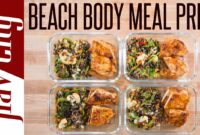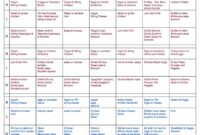Dieta South Beach Phase 1 initiates a dietary journey focused on controlled carbohydrate intake and prioritizes healthy fats and lean proteins. This initial phase emphasizes rapid weight loss while establishing sustainable eating habits. Understanding the principles behind allowed and restricted foods is key to successful implementation and achieving the desired results. This guide delves into the nutritional aspects, potential benefits and drawbacks, practical considerations, and important considerations for various health conditions.
We will explore the macronutrient balance, potential effects on blood sugar, and the vitamin and mineral profile of this dietary approach. Practical tips for meal planning, recipe ideas, and strategies for managing cravings will also be provided to ensure a smooth and successful transition into Phase 1. Finally, we will address the importance of consulting a healthcare professional before embarking on any significant dietary change, particularly for individuals with pre-existing health conditions.
Overview of the South Beach Diet Phase 1
The South Beach Diet Phase 1 is a two-week induction phase designed to jumpstart weight loss and improve metabolic health. It focuses on eliminating refined carbohydrates and unhealthy fats while emphasizing lean protein, healthy fats, and non-starchy vegetables. This initial phase aims to stabilize blood sugar levels, reduce cravings, and promote early weight loss success, setting the stage for the subsequent phases.
Core Principles of the South Beach Diet Phase 1
The core principle revolves around controlling blood sugar levels through strategic carbohydrate selection. Phase 1 restricts simple carbohydrates, which cause rapid spikes in blood sugar, leading to energy crashes and increased hunger. Instead, it prioritizes complex carbohydrates, which are digested more slowly, promoting sustained energy and satiety. This approach also helps regulate insulin levels, crucial for effective weight management. The diet also emphasizes consuming healthy fats, which provide sustained energy and support overall health.
Allowed and Restricted Foods in Phase 1
The South Beach Diet Phase 1 allows a wide variety of nutrient-rich foods. Lean proteins such as fish, poultry (without skin), and lean cuts of meat are encouraged. Healthy fats like olive oil, avocados, nuts (in moderation), and seeds are also permitted. Non-starchy vegetables, including leafy greens, broccoli, peppers, and cauliflower, form the base of most meals. Furthermore, eggs and low-fat dairy products (such as skim milk and Greek yogurt) are acceptable.
Foods restricted in Phase 1 include sugary drinks (soda, juice), refined carbohydrates (white bread, pasta, pastries), most fruits (except berries in moderation), and unhealthy fats (trans fats and saturated fats from processed foods). Processed foods, packaged snacks, and sugary cereals are also strictly avoided. The rationale behind these restrictions is to minimize rapid blood sugar fluctuations and to prioritize nutrient-dense foods that promote satiety and overall health.
Rationale Behind the Food Choices in Phase 1
The selection of foods in Phase 1 is based on their glycemic index (GI) and glycemic load (GL). Foods with a low GI and GL are preferred, as they cause a slower and more gradual rise in blood sugar. This helps prevent insulin resistance, a key factor in weight gain and metabolic disorders. The emphasis on lean protein and healthy fats promotes satiety, helping to control appetite and prevent overeating. The inclusion of non-starchy vegetables provides essential vitamins, minerals, and fiber, contributing to overall health and well-being.
Sample One-Day Meal Plan for Phase 1
This sample meal plan provides a balanced intake of protein, healthy fats, and non-starchy vegetables, adhering to the South Beach Diet Phase 1 guidelines. Portion sizes can be adjusted based on individual caloric needs.
| Meal | Food Item | Serving Size | Nutritional Information (Approximate) |
|---|---|---|---|
| Breakfast | Scrambled eggs with spinach and mushrooms | 2 eggs, 1 cup spinach, ½ cup mushrooms | ~300 calories, 20g protein, 15g fat, 5g carbs |
| Lunch | Grilled chicken salad with mixed greens, avocado, and olive oil dressing | 4 oz chicken, 2 cups greens, ¼ avocado, 1 tbsp olive oil | ~400 calories, 35g protein, 25g fat, 10g carbs |
| Dinner | Baked salmon with roasted asparagus and broccoli | 4 oz salmon, 1 cup asparagus, 1 cup broccoli | ~450 calories, 30g protein, 25g fat, 15g carbs |
| Snack | Handful of almonds | ~1/4 cup | ~200 calories, 6g protein, 18g fat, 6g carbs |
Phase 1 and Different Health Conditions
The South Beach Diet Phase 1, with its strict limitations on carbohydrates and emphasis on healthy fats and lean proteins, can significantly impact individuals with various health conditions. It’s crucial to understand these potential effects and the importance of medical supervision before embarking on this or any restrictive diet. The information below is for educational purposes and should not be considered medical advice.
Phase 1 and Diabetes Management
Phase 1’s low-carbohydrate nature can be beneficial for some individuals with type 2 diabetes. By reducing carbohydrate intake, blood sugar levels may become more stable and require less insulin or oral medication. However, this effect is not universal, and some individuals might experience adverse effects like hypoglycemia (low blood sugar). Careful monitoring of blood glucose levels is essential, and adjustments to medication may be necessary under a doctor’s guidance. For example, a person taking insulin might need a dosage reduction to avoid dangerously low blood sugar. Conversely, individuals with type 1 diabetes should proceed with extreme caution and only under the strict supervision of their endocrinologist, as insulin requirements might change significantly.
Phase 1 and Cardiovascular Health
The South Beach Diet Phase 1, focusing on lean protein and healthy fats, can positively influence cardiovascular health by lowering cholesterol and blood pressure in some individuals. The reduction in saturated and trans fats contributes to improved lipid profiles. However, individuals with pre-existing heart conditions, such as coronary artery disease, should exercise caution. The initial reduction in sodium intake can be beneficial, but it is vital to consult with a cardiologist before starting this diet, as it could interact with certain heart medications. For instance, some medications for high blood pressure might need adjustment if the diet significantly lowers blood pressure.
Medication Interactions and Dietary Considerations
Several medications can interact with the dietary restrictions of Phase 1. For example, some medications for diabetes or high blood pressure may require adjustments if blood sugar or blood pressure levels change significantly due to the diet. Certain diuretics might also interact with the electrolyte balance affected by dietary changes. It is imperative to discuss the diet plan with a pharmacist and physician to identify potential drug-diet interactions and make necessary adjustments to medication dosages. Always inform your healthcare provider about any supplements you are taking, as these can also interact with medications or the diet itself.
Importance of Consulting a Healthcare Professional
Before starting the South Beach Diet Phase 1, or any other restrictive diet, it is crucial to consult with a healthcare professional, especially if you have pre-existing health conditions. This is particularly important for individuals with diabetes, heart disease, kidney disease, or other chronic illnesses. A doctor can assess your individual health status, evaluate potential risks and benefits, and help you make informed decisions regarding your dietary choices and medication adjustments. They can also monitor your progress and make necessary modifications to your diet plan as needed.
Dietary Adjustments for Allergies and Intolerances
Individuals with food allergies or intolerances need to make appropriate adjustments to the South Beach Diet Phase 1. For example, someone with a dairy allergy must eliminate dairy products and find suitable alternatives. Similarly, those with gluten intolerance must avoid gluten-containing foods. Careful planning and substitution of foods are crucial to ensure adequate nutrition while adhering to the dietary restrictions. Working with a registered dietitian can help create a personalized plan that accommodates individual needs and preferences while maintaining the core principles of the diet.
Closing Summary
Successfully navigating Dieta South Beach Phase 1 requires a balanced understanding of its principles and a commitment to consistent practice. While the initial phase prioritizes rapid weight loss, long-term success hinges on establishing sustainable healthy eating habits. Remember to prioritize whole, unprocessed foods, manage cravings effectively, and consult your healthcare provider for personalized guidance. By incorporating the knowledge and strategies outlined in this guide, you can embark on this dietary journey with confidence and increase your chances of achieving your health goals.




